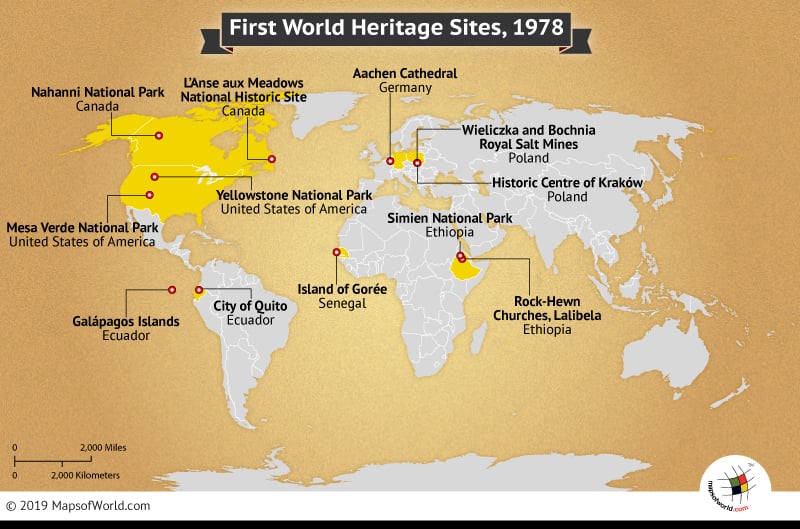

World Map Depicting The First World Heritage Sites
The world is dotted with beautiful structures and monuments. However, many jaw-dropping monuments/structures have now become just a part of history books due to centuries of neglect, conflict, and anti-social activities. Nevertheless, there are a number of amazing structures that are still standing tall thanks to the painstaking efforts of UNESCO. Designated as World Heritage Sites, these structures/monuments have significant cultural and historical significance and are deemed important for humanity’s collective interest.
History
The history of the World Heritage Sites dates back to the construction of the Aswan High Dam. The government of Egypt initiated worked on the dam in 1954. Though beneficial for the Egyptian economy, the dam proved detrimental to the priceless ancient Egyptian and ancient Nubian cultural treasures. The reservoir created by the dam was to flood a huge stretch of the Nile Valley, which also meant drowning and destroying a large number of treasures. Thus, the governments of Sudan and Egypt went into a panic mode and requested UNESCO to help them in saving the monuments from getting destroyed. Thereafter began a rescue operation whereby many sites and treasures were recovered while some were also relocated to higher ground. This massive operation brought to the fore the fact that there should be a permanent mechanism to ensure that our ancient artifacts, structures, and monuments are preserved. Thus, the Convention Concerning the Protection of the World Cultural and Natural Heritage was adopted by UNESCO on November 19, 1972. The year 1978 witnessed the creation of the World Heritage List which saw the inclusion of 12 historical monuments from around the world. Today, there are a total of 1,092 World Heritage Sites across the globe.
The First 12 Heritage Sites
The inaugural list of World Heritage Sites witnessed monuments, structures, and places in the continents of Europe, Americas, and Africa. The sites selected in the US included Yellowstone National Park, that is home to one of the few intact ecosystems that still exists, and Mesa Verde National Park, which is home to the ancient Pueblo dwelling that dates back between the 6th and the 12th centuries. L’Anse aux Meadows National Historic Park in Canada is home to the first and only Viking site in the whole of North America. Nahanni National Park was another site from Canada that was a part of the inaugural list.
The other sites that were a part of the 1978 list were Aachen Cathedral in Germany, City of Quito, and the Galápagos Islands in Ecuador, Historic Centre of Krakow, Wieliczka and Bochnia Royal Salt Mines in Poland, Rock-Hewn Churches, Lalibela and Simien National Park in Ethiopia, and the Island of Gorée in Senegal.
Know More About: New World Heritage Sites of 2018
The Republic of Madagascar is an island country located in the Indian Ocean, off the…
The Euro is the official currency of the European Union. It is, however, not incumbent…
There are many countries or regions that are partially recognized by the UN, have disputes…
The Alaska Statehood Act was signed into law by President Dwight D. Eisenhower in 1958,…
The name Persia may, however, only be used to refer to Iran in some contexts.…
Hawaii is an Island State in the US. It is one of the 50 states…